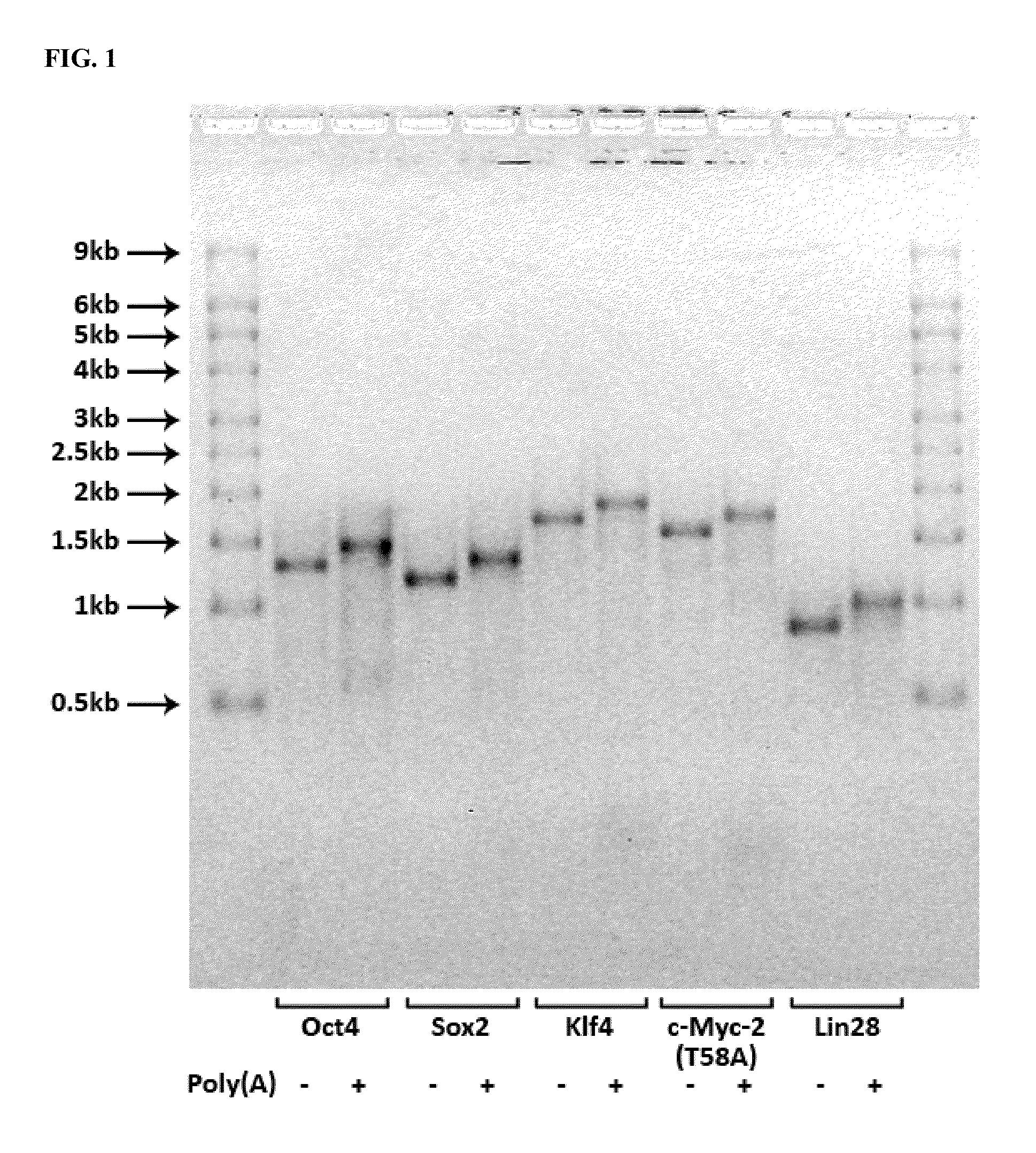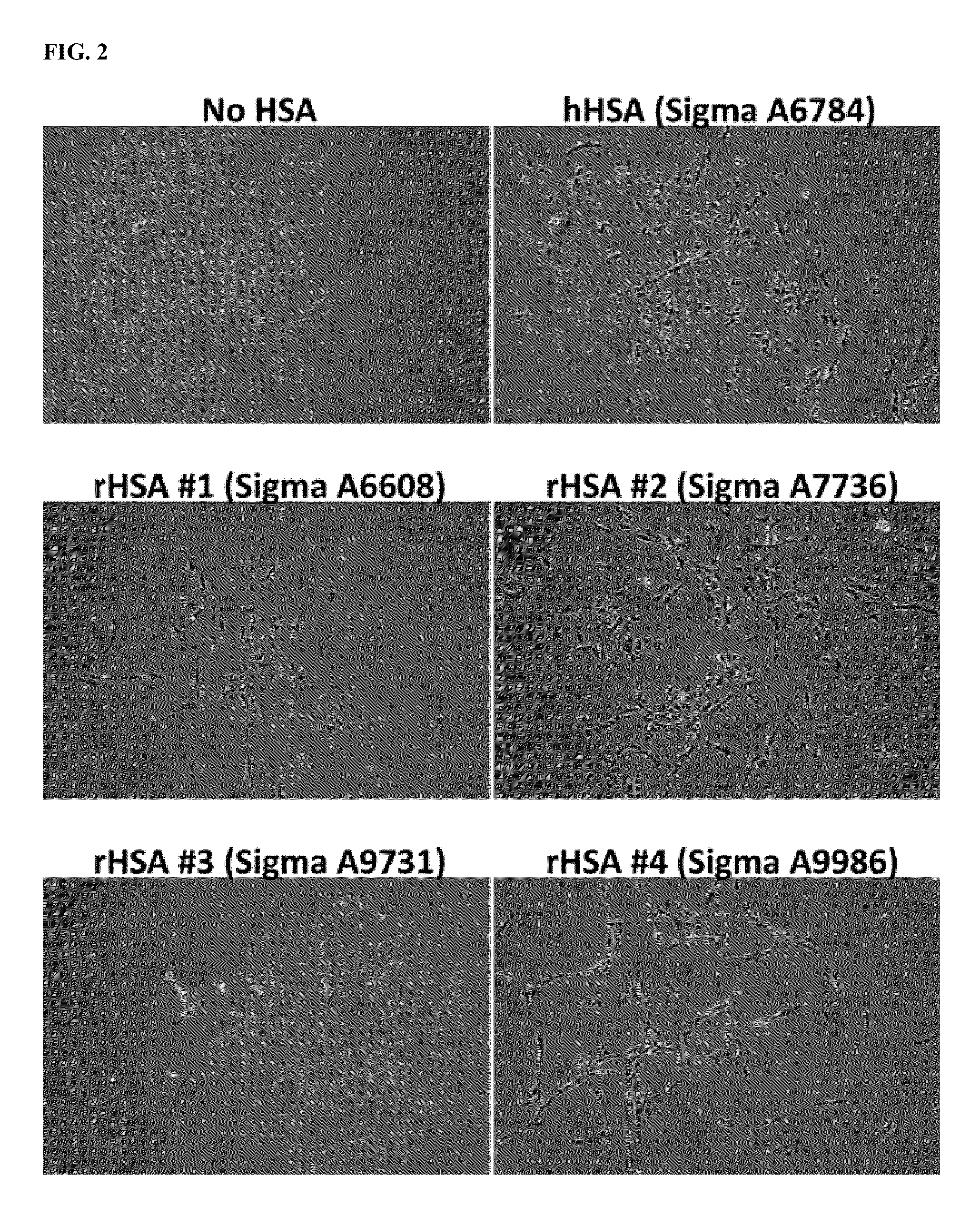Methods and products for transfection
a technology of products and methods, applied in the field of methods and products for transfection, can solve the problems of increasing the toxicity of transfection, cell death when cells are killed, and the design of a transfection protocol is made even more difficul
- Summary
- Abstract
- Description
- Claims
- Application Information
AI Technical Summary
Benefits of technology
Problems solved by technology
Method used
Image
Examples
example 1
Synthesis of Reprogramming RNA
[0109]RNA encoding the human proteins Oct4, Sox2, Klf4, c-Myc-2 (T58A), and Lin28 and comprising adenosine, guanosine, pseudouridine, and 5-methylcytidine residues17-20, was synthesized from DNA templates using the T7 High Yield RNA Synthesis Kit (New England Biolabs, Inc.), according to the manufacturer's instructions. The resulting RNA was analyzed by agarose gel electrophoresis to assess the quality of the RNA (FIG. 1). The RNA was then diluted to 200 ng / μL, and an RNase inhibitor (Superase-In™, Life Technologies Corporation) was added at a concentration of 1 μL / 100 μg of RNA. RNA solutions were stored at 4 C indefinitely. RNA encoding Oct4, Sox2, Klf4, c-Myc-2 (T58A), and Lin28 was mixed at a molar ratio of 3:1:1:1:1.
example 2
Transfection of Cells with Reprogramming RNA
[0110]2 ug RNA and 6 μL transfection reagent (Lipofectamine™ RNAiMAX, Life Technologies Corporation) were first diluted separately in complexation medium (Opti-MEM®, Life Technologies Corporation) to a total volume of 60 μL each. Diluted RNA and transfection reagent were then mixed and incubated for 15 min at room temperature, according to the transfection reagent-manufacturer's instructions. Complexes were then added to cells in culture. Between 60 μL and 120 μL of complexes were added to each well of a 6-well plate, which already contained 2 mL of transfection medium per well. Plates were then shaken gently to distribute the complexes throughout the well. Cells were incubated with complexes for 2 hours to overnight, before replacing the medium with fresh transfection medium (2 mL / well).
example 3
Analysis of the Ability of Untreated Human Serum Albumin Preparations to Support Nucleic Acid Transfection and RNA Reprogramming
[0111]Primary human neonatal fibroblasts were cultured in medium with or without 5 mg / mL HSA. Cohn Fraction V (A6784, Sigma-Aldrich Co. LLC.), and four different recombinant HSA preparations (A6608, A7736, A9731, and A9986, all from Sigma-Aldrich Co. LLC.) were screened. Cells were transfected according to Example 2, with RNA synthesized according to Example 1. While untransfected cells grew well in media containing any of the HSA preparations, in transfected wells, each of the HSA preparations yielded dramatically different cell morphologies and cell densities, and none resulted in morphological changes indicative of reprogramming (FIG. 2).
PUM
| Property | Measurement | Unit |
|---|---|---|
| concentration | aaaaa | aaaaa |
| time | aaaaa | aaaaa |
| time | aaaaa | aaaaa |
Abstract
Description
Claims
Application Information
 Login to View More
Login to View More - R&D
- Intellectual Property
- Life Sciences
- Materials
- Tech Scout
- Unparalleled Data Quality
- Higher Quality Content
- 60% Fewer Hallucinations
Browse by: Latest US Patents, China's latest patents, Technical Efficacy Thesaurus, Application Domain, Technology Topic, Popular Technical Reports.
© 2025 PatSnap. All rights reserved.Legal|Privacy policy|Modern Slavery Act Transparency Statement|Sitemap|About US| Contact US: help@patsnap.com



